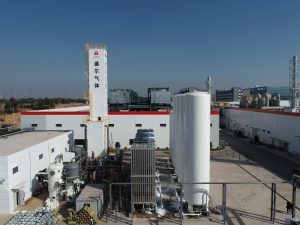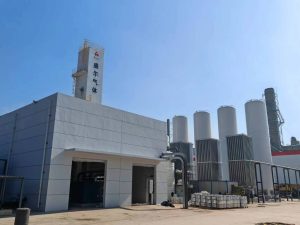Introduction
Every large industrial plant relies on air — not just for combustion, but as the raw material for oxygen and nitrogen.
Turning that ordinary air into pure gases has always been the job of the cryogenic air separation unit (ASU).
It’s not a new idea, but over the years the process has been refined: compressors are quieter, columns are cleaner, and control systems react faster than the operators once could.
In most steel, glass, and chemical facilities today, an ASU runs quietly in the background, steady as a heartbeat, keeping the gas lines full day and night.
At Sheng Er Gas HK, we still view this as one of the most disciplined forms of engineering — balancing temperature, pressure, and energy with precision.
This guide looks at how a modern cryogenic ASU is built and why, even in 2025, it remains the most dependable way to make industrial gases at scale.
It’s written for readers who prefer practical detail to promotion: the kind of people who care about design margins, purity numbers, and real operating data.
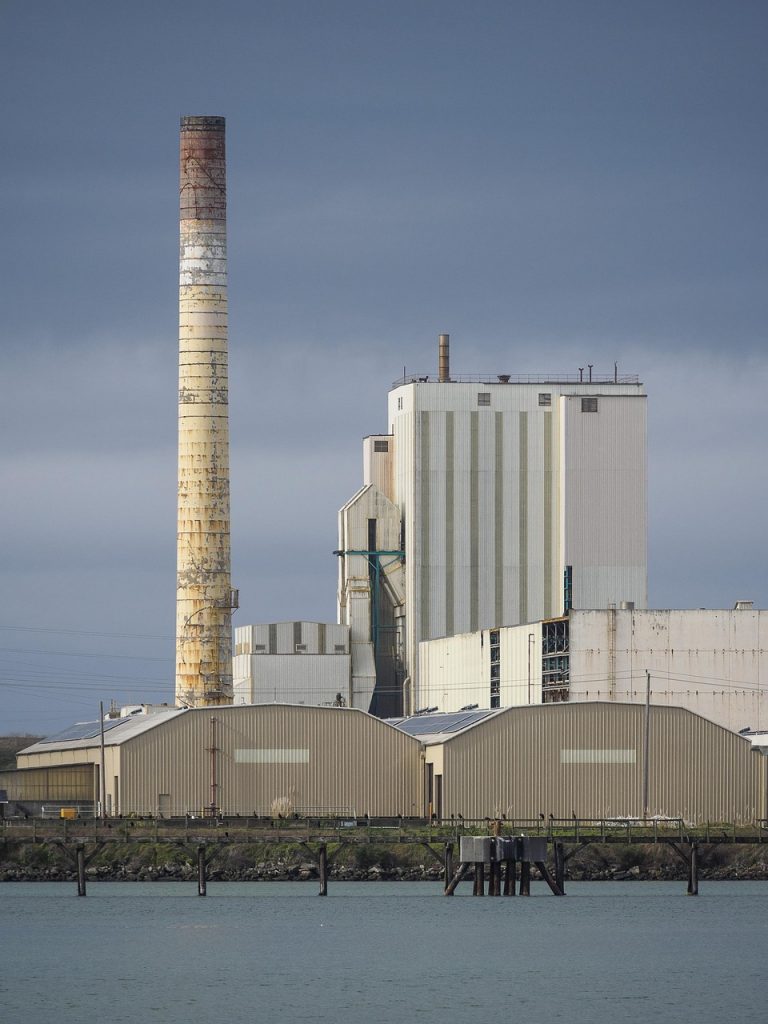
Understanding Cryogenic Air Separation Units
A cryogenic ASU (air separation unit) is an industrial plant that separates atmospheric air into pure oxygen, nitrogen, and other gases via low-temperature distillation. Unlike smaller nitrogen generators or oxygen concentrators, cryogenic ASUs are large-scale systems designed for maximum purity and throughput. They operate on the principle that each gas in air has a unique boiling point; by cooling air to cryogenic temperatures, gases liquefy and can be isolated. Below is an overview of how a typical cryogenic air separation process works:
- Air Compression: Ambient air is drawn into the ASU and compressed to a high pressure by multi-stage compressors. This raises the air pressure to the levels needed for efficient downstream processing.
- Purification: The pressurized air is passed through purification units (molecular sieve absorbers) to remove moisture, carbon dioxide, and hydrocarbons. These impurities must be eliminated to prevent freezing or blockages in the cryogenic equipment.
- Cooling & Liquefaction: Next, the clean, dry air is cooled in heat exchangers to cryogenic temperatures (around –185 °C or –300 °F). By employing refrigeration cycles (often using expanding turbine expanders), the air is chilled until most of it condenses into a liquid.
- Distillation in Column: The liquefied air is fed into a tall insulated distillation column system (typically a double-column design with high-pressure and low-pressure sections). Inside this distillation column, the separation occurs based on boiling points: oxygen (boiling at –183 °C) and nitrogen (boiling at –196 °C) begin to separate. Oxygen tends to remain in the liquid phase at the bottom of the column, while nitrogen preferentially vaporizes and rises to the top. By carefully controlling pressure and temperature, the ASU produces two primary streams – a bottoms liquid rich in oxygen and a tops vapor rich in nitrogen. An internal heat exchanger called a condenser-reboiler connects the two columns, allowing oxygen in the low-pressure column to evaporate and nitrogen in the high-pressure column to condense, achieving high-purity splits.
- Product Extraction: The separated gases are extracted as products. Oxygen is typically withdrawn from the lower column as a gas (or pumped as a liquid) with purity up to ~99.5%. Nitrogen gas comes off the top of the low-pressure column at high purity (often 99.9% or above). Modern cryogenic ASUs also often include an argon side-column to recover argon (~1% of air) at ~99.9% purity if needed. Nitrogen recovery in these systems is high – most of the incoming air’s nitrogen can be captured as product rather than vented. The resulting oxygen and nitrogen streams are warmed back to ambient temperature via heat exchangers and delivered to supply lines or liquefiers as required.
Once started, a cryogenic ASU runs continuously 24/7, with automated control systems maintaining steady output and oxygen purity levels. These air separation unit plants are highly reliable “workhorses” of industry – often operating for years with minimal shutdowns. However, they are also capital-intensive and energy-intensive, involving large compressors, expansion turbines, and insulated cold boxes. The advantage is that cryogenic ASUs can achieve extremely pure gases and very large capacities that alternative technologies (like PSA or membrane systems) cannot match. In summary, a cryogenic ASU provides on-demand industrial gases at the scale and purity needed for heavy industry operations.In 2025, the demand for Cryogenic Air Separation Units (ASUs) continues to expand across global industries.
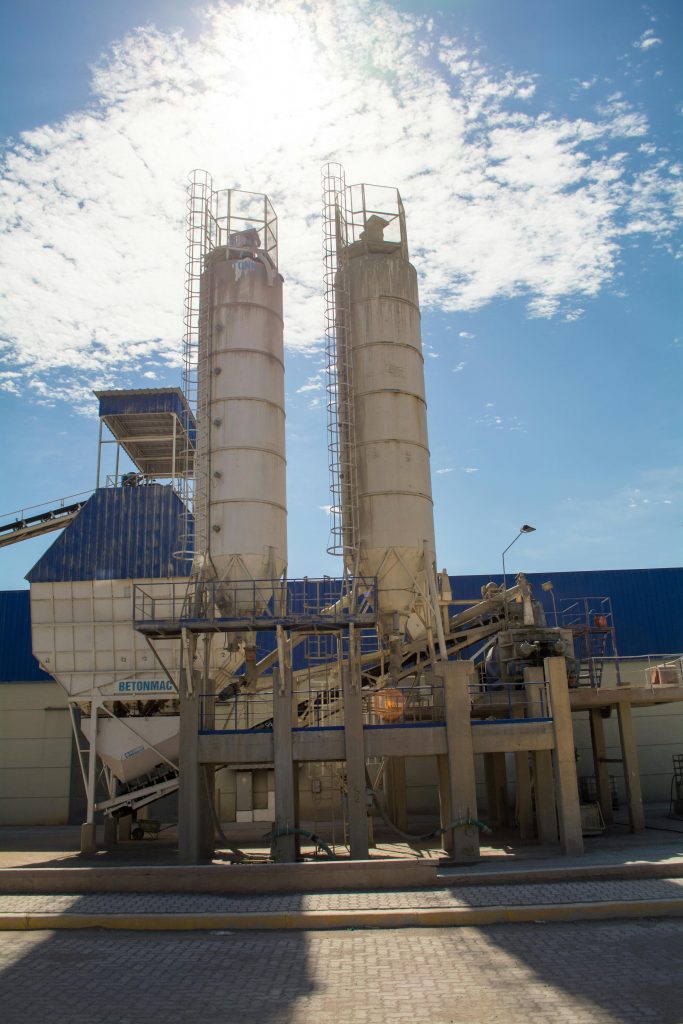
Performance and Production Specifications
Table 1: Typical Performance Parameters for a Cryogenic Air Separation Unit (ASU)
| Parameter | Typical Specification |
|---|---|
| Oxygen Purity (O₂) | Up to 99.5–99.9% (high-purity oxygen output) |
| Nitrogen Recovery (N₂) | ~95–99% of feed air’s nitrogen can be captured as product |
| Capacity Range | ~100 to 5,000+ tons O₂ per day (per ASU unit), plus co-product N₂ |
| Specific Power Consumption | ~0.3–0.6 kWh per Nm³ O₂ (approx. 250–500 kWh per ton O₂ produced) |
Table 1: Typical performance parameters for a cryogenic air separation unit.These parameters define the operational performance of a modern cryogenic ASU.
Oxygen purity from cryogenic plants is usually 99+%, suitable for even the most demanding processes (e.g. oxy-fuel combustion or medical oxygen at 99.5% O₂). Nitrogen product gas is often delivered at 99.9% to 99.999% purity for applications like electronics. As shown, nitrogen recovery in a well-optimized ASU can approach nearly 100%, meaning very little of the air’s nitrogen is wasted – it can be fully utilized on-site (or liquefied for storage). The capacity of cryogenic ASUs spans a broad range: small units might produce 100–200 tons of oxygen per day, while large industrial complexes (like steel mills or petrochemical hubs) install ASUs delivering several thousand tons per day of O₂ (plus corresponding N₂). Such large ASUs represent some of the biggest industrial units in operation, often requiring tens of megawatts of power. Energy efficiency is therefore a key design factor – specific power consumption typically ranges from about 0.3 kWh/Nm³ O₂ in state-of-the-art large plants to 0.5+ kWh/Nm³ in older or smaller setups. In practical terms, a 1,000 TPD oxygen ASU might draw roughly 20–25 MW of electrical power. Continuous improvements in design (better heat integration, advanced compressors, etc.) have steadily reduced energy use per unit of oxygen produced, making today’s ASUs about 10–20% more efficient than those a decade ago.
Cryogenic ASUs in Glass Manufacturing
Glass manufacturing, especially container-glass production, has widely adopted cryogenic ASUs to supply oxygen for oxy-fuel furnaces. In a traditional glass furnace, combustion uses normal air, meaning nearly 80% of what enters the burner is nitrogen that does not burn. By switching to oxygen-enriched combustion (or full oxy-fuel where fuel is burned in pure oxygen), glass plants can dramatically improve their efficiency. Cryogenic ASU systems enable this by providing a constant stream of high-purity oxygen on site. For instance, using almost pure oxygen instead of air boosts flame temperatures and eliminates the ballast of nitrogen. This leads to roughly 20%–25% lower fuel consumption in glass melting, as more of the heat goes into melting glass rather than heating useless N₂. Higher flame temperature and stability also improve melting throughput and product quality. Many container-glass makers report that furnace energy efficiency climbs significantly with oxy-fuel – the furnace can achieve the same production using much less fuel, reducing operating cost. Emissions are another major benefit: nitrogen oxides (NOx) formation drops by 70% or more because there’s far less nitrogen in the furnace to generate NOx. CO₂ emissions fall as well (often ~20% lower) due to reduced fuel usage and more complete combustion in an oxygen-rich flame.
In practice, a cryogenic ASU supplying a glass plant might deliver oxygen at 95–99.5% purity through pipelines directly to the burners. The air separation unit becomes a utility feed much like an internal power plant, ensuring the furnace never runs out of oxygen. High oxygen purity from the ASU is critical – it allows full oxy-fuel operation without diluting the flame, which maximizes the efficiency and emissions gains. Lower-purity oxygen (from non-cryogenic sources like PSA generators, which are typically 90–95%) would introduce some nitrogen and diminish these benefits. Another advantage of on-site ASU is scale and reliability: glass furnaces operate 24/7, and cryogenic plants run continuously to match that demand. They can be built to produce the huge volumes required by large furnaces (hundreds or thousands of Nm³ of O₂ per hour), a scale at which other technologies struggle. Additionally, the nitrogen recovery aspect of an ASU is useful in glass manufacturing. The excess nitrogen produced can be used to purge and inert certain processes in the plant. For example, nitrogen gas is often used in the glass annealing lehr (cooling oven) to prevent oxidation or discoloration of hot glass, and to provide a protective atmosphere. Having a built-in nitrogen source from the ASU saves the plant from having separate nitrogen generators or liquid nitrogen deliveries. Overall, cryogenic ASUs have become a cornerstone of energy-efficient, low-emission glass production by enabling on-demand oxygen at the necessary purity and scale.
Cryogenic ASUs in Steel Production
The steel industry was one of the earliest adopters of large air separation unit plants, and it continues to rely on cryogenic ASUs for both oxygen and inert gases. In integrated steel mills, blast furnaces and basic oxygen furnaces (BOF) consume enormous quantities of oxygen to convert iron into steel. A cryogenic ASU can supply high-purity oxygen for these processes, significantly accelerating chemical reactions and boosting productivity. For example, in BOF steelmaking (also known as converter steelmaking), blowing pure oxygen into molten iron reduces the carbon content rapidly – this oxygen supply shortens the conversion time by around 25–30% compared to air-based methods. The intense reaction raises temperature efficiently, improving thermal energy utilization. In electric arc furnace (EAF) steelmaking, oxygen lancing is used to cut scrap and increase heat, also benefiting from on-site O₂. By having an ASU on the premises, steel plants ensure a stable oxygen feed at all times, which is vital for their 24-hour operations. The oxygen purity (typically 99% O₂) from a cryogenic ASU helps achieve consistent steel quality and faster melting cycles.
Beyond oxygen, steel production also demands large volumes of nitrogen and argon, which cryogenic ASUs conveniently co-produce. Nitrogen is used in steel mills for various purposes: as a carrier gas in injection systems, for purging and stirring molten metal (to homogenize temperature and composition), and to create inert atmospheres in certain processes (for example, preventing oxidation in continuous casting or in heat treatment furnaces for finished steel). Having high nitrogen recovery from the on-site ASU means the mill has essentially a limitless supply of nitrogen gas without needing separate systems. Argon is another critical gas in steelmaking – it’s blown into ladles during secondary metallurgy (ladle refining) to stir molten steel gently and remove impurities. Cryogenic ASUs with an argon extraction column can supply argon alongside O₂ and N₂, which is a major advantage for integrated steelworks. The capacity requirements in steel are huge: large ASUs (some producing 3,000–5,000 tons of O₂ per day) are often installed to meet the combined oxygen and inert gas needs of a steel complex. These plants operate with economies of scale, making the cost per unit of oxygen or nitrogen very competitive. However, they do require significant power and investment – often becoming a key part of the steel plant’s infrastructure. In summary, cryogenic ASU technology is indispensable in steel manufacturing, delivering oxygen for high-temperature reactions and simultaneously providing nitrogen/argon for shielding and processing. This ensures higher productivity, improved quality of steel, and safer operations (through ample inert gas for fire prevention and purging).
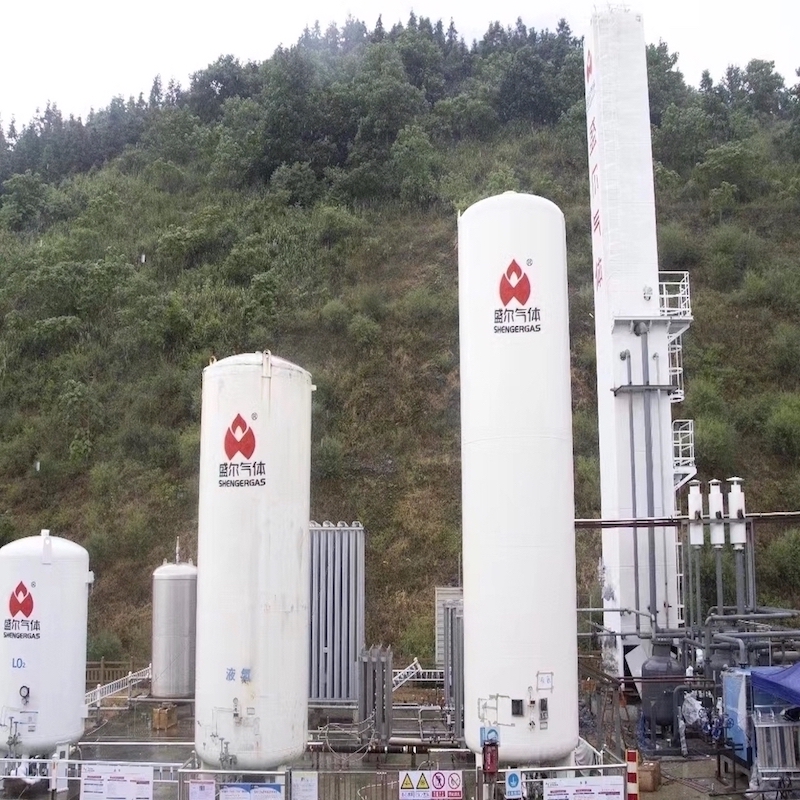
Cryogenic ASUs in Petrochemical and Refining Industries
In refinery and chemical operations, the Cryogenic Air Separation Unit (ASU) is the main source of high-purity oxygen and nitrogen that supports continuous plant performance.
Refineries and petrochemical plants depend on a steady supply of industrial gases, and air separation units are frequently integrated on-site to fulfill these needs. In these environments, oxygen and nitrogen serve different but equally important roles. Oxygen is used in processes like partial oxidation, gasification, and oxidative reactors. For instance, modern refineries may gasify heavy residues or petcoke with oxygen to produce syngas (a mixture of CO and H₂) for hydrogen production or power generation. These gasifiers require high-purity oxygen (often 95–99% O₂) to run efficiently, which cryogenic ASUs readily provide. Another example is ethylene oxide production in petrochemicals, which reacts ethylene with pure oxygen – on-site ASUs ensure a safe, pure O₂ feed for this highly exothermic reaction. By using oxygen instead of air in such processes, plants can increase throughput (oxygen-enriched reactions proceed faster) and avoid the diluting effect of nitrogen. The result is higher productivity and often lower CO₂ emissions per unit of product, since less fuel is wasted heating inert nitrogen. Oxygen from a cryogenic ASU is also vital for sulfur recovery units (Claus process) in refineries, where oxygen-based reactors can boost sulfur recovery efficiency and capacity.
In modern petrochemical plants, the Cryogenic Air Separation Unit (ASU) is the core equipment supplying both oxygen and nitrogen for continuous production.
Nitrogen is even more widely used across petrochemical operations as an inert gas. An on-site cryogenic ASU provides essentially unlimited nitrogen, which is used for purging equipment, blanketing storage tanks, and maintaining inert atmospheres in reactors and pipelines. Safety is a prime concern in these industries – filling the vapor space of flammable liquid tanks with nitrogen prevents explosive mixtures from forming. Nitrogen purges clear out oxygen and volatile hydrocarbons from process equipment before maintenance, averting fire hazards. Having a large nitrogen recovery capability means the ASU can supply all these needs continuously, with purity usually around 99.9% to ensure no oxygen gets into sensitive units. Some petrochemical processes also use nitrogen as a coolant or to pneumatically convey powders and catalysts. In large ammonia or methanol plants (which often fall under “petrochemical”), an ASU might serve a dual purpose: providing oxygen for the gasifiers or reformers, and nitrogen for the ammonia synthesis loop (ammonia is made from N₂ and H₂). In such cases, the co-production aspect of cryogenic ASUs is extremely advantageous – the oxygen stream feeds one part of the process while the nitrogen stream feeds another. Capacity-wise, petrochemical facilities typically require ASUs in the mid to large scale (hundreds to thousands of tons O₂ per day), similar to steel plants, because of the massive volumes of gases consumed. Reliability is crucial since these plants run continuously; any disruption in oxygen or nitrogen supply can force a unit shutdown. Thus, operators value the robust design of cryogenic ASUs and often have redundant systems or backup liquid storage to ensure an uninterrupted gas supply. By installing cryogenic ASUs, petrochemical complexes achieve greater self-sufficiency, improved process performance, and enhanced safety through on-demand inerting.
Cryogenic ASUs in Electronics Manufacturing
In modern electronics manufacturing, the Cryogenic Air Separation Unit (ASU) plays a critical role in supplying ultra-high purity gases used for wafer processing and cleanroom operations. These cryogenic ASU systems generate nitrogen and oxygen with unmatched purity levels required by advanced semiconductor and display industries.
Electronics manufacturing – including semiconductor fabs, display panel factories, and LED production – requires ultra-high purity gases, particularly nitrogen. Cryogenic ASU installations are commonly found at large semiconductor fabrication facilities to provide “electronic grade” nitrogen in massive quantities. In chip manufacturing, nitrogen gas with purity 99.999% (five nines) or better is used to purge process chambers, pipelines, and to blanket wafers during critical steps. This prevents any oxygen or moisture from contaminating sensitive materials like silicon wafers or reactive chemicals. Even trace impurities can ruin batches of chips, so the oxygen purity in nitrogen must be extremely low (i.e. nitrogen must be almost completely oxygen-free). Cryogenic ASUs are uniquely suited to this task because they inherently produce high-purity nitrogen; by distilling air, they can strip out nearly all oxygen and moisture. The delivered nitrogen is dry, very pure, and stable. In contrast, alternative nitrogen generators (PSA or membranes) typically max out at 99.9% purity and may still allow small oxygen or water vapor traces, which is unacceptable for top-tier electronics production.
A typical electronics ASU will supply nitrogen continuously to the fab, often in the range of several thousand cubic meters per hour for a large plant. The ASU may also produce liquid nitrogen that can be stored on site as backup or used for cooling applications (e.g., cold temperature testing or transporting wafers at cryogenic temperatures). Energy use is a consideration – these plants operate around the clock, and maintaining energy efficiency while ensuring purity is important for cost control – but modern designs have improved in this regard with optimized heat exchangers and efficient turbines. While oxygen is not needed in the same bulk amounts in a semiconductor fab, cryogenic ASUs can also produce high-purity oxygen for processes like thermal oxidation of silicon or for etching processes that use controlled oxygen atmospheres. Similarly, argon from an ASU is valuable for semiconductor processes (like sputtering and plasma etching) due to its inertness. By installing an on-site air separation unit, electronics manufacturers gain a secure and ultra-clean gas supply that meets stringent industry specs. Moreover, they benefit from the nitrogen recovery being effectively total – all the required nitrogen is generated from air without reliance on delivered cylinders or liquid dewars, which simplifies logistics and reduces contamination risk. In summary, cryogenic ASUs enable the electronics sector to operate at the purity and precision it demands, supplying large volumes of nitrogen economically and reliably, which ultimately helps in achieving high yields and product quality in advanced manufacturing.
Energy Efficiency Improvements and 2025 Trends
Recent innovations in cryogenic ASU design focus on lowering specific power consumption.As of 2025, one of the key focuses in cryogenic ASU design and operation is improving energy efficiency. Traditional cryogenic air separation is energy-intensive, mainly due to the power needed for air compression and refrigeration. However, recent advancements have made new ASUs significantly more efficient than older generations. Manufacturers have achieved roughly 10–15% reductions in specific energy consumption over the past decade by employing several strategies. Energy efficiency gains come from optimized process cycles (for example, better integration of heat exchangers and expansion turbines to reclaim more cold energy within the process), as well as improved equipment. Modern air compressors and turbo-expanders are designed with higher aerodynamic efficiency and better materials, cutting down electricity use. Some large ASU facilities now incorporate waste heat recovery systems – for instance, using the heat from compressor inter-coolers or expansion stages to produce steam or to preheat other processes on site, thus utilizing energy that would otherwise be lost. There is also a trend toward more flexible operation of ASUs to match power grid fluctuations. Advanced control systems and liquefaction storage allow an ASU to ramp production up or down and shift some loads to off-peak hours, improving overall energy management without compromising supply to the plant. This flexibility can lower operating costs and even enable ASUs to act as a form of energy storage (by making liquid products when power is cheap and using them later).
Another 2025 trend is the integration of smart monitoring and Industry 4.0 principles in air separation units. Operators now use predictive analytics and IoT sensors to continuously monitor ASU performance, aiming to detect fouling, wear, or inefficiencies early. By analyzing real-time data, the control system can fine-tune operating parameters to maintain optimal energy efficiency and reliability. Predictive maintenance algorithms help schedule outages at ideal times, minimizing unplanned downtime. These digital advancements complement the strong baseline reliability of cryogenic ASUs, making them even more dependable and cost-effective. On the process side, research continues into novel cycle designs like integrating pressure swing adsorption pre-concentration or using new distillation column configurations to reduce energy needs. While cryogenic distillation remains the dominant method for large-scale oxygen production in 2025, there is interest in hybrid systems that could further cut power usage. For example, improvements in nitrogen recovery and oxygen capture efficiency directly translate to less wasted refrigeration effort. Looking ahead, we can expect cryogenic ASUs to keep evolving toward lower specific power consumption and more eco-friendly operation – an important consideration as industries aim to reduce carbon footprints. In summary, the current trend is clear: future air separation unit installations will be smarter, more energy efficient, and better integrated into the industrial ecosystems they serve.Smart automation has become standard in modern cryogenic air-separation units.
Conclusion
Cryogenic ASUs have proven to be an enabling technology for heavy industry and high-tech manufacturing alike, providing the foundation for on-site gas production with unmatched purity and scale. In this Cryogenic ASU Guide 2025, we reviewed how these air separation unit systems operate and examined their impact on applications in glass, steel, petrochemical, and electronics sectors. The analysis shows that cryogenic ASUs drive higher efficiency, better product quality, and cleaner operations by delivering oxygen and nitrogen exactly where and when they’re needed. Importantly, ongoing improvements in design and energy efficiency are ensuring that ASUs remain economically and environmentally viable for years to come. As industries push for greater productivity and sustainability, cryogenic air separation will continue to play a pivotal role in meeting gas demands safely and efficiently. Sheng Er Gas HK, Cryogenic Air Separation Units (ASU) remain the foundation of industrial gas supply. Sheng Er Gas HK continues to develop advanced ASU systems for efficient and sustainable oxygen and nitrogen production.

